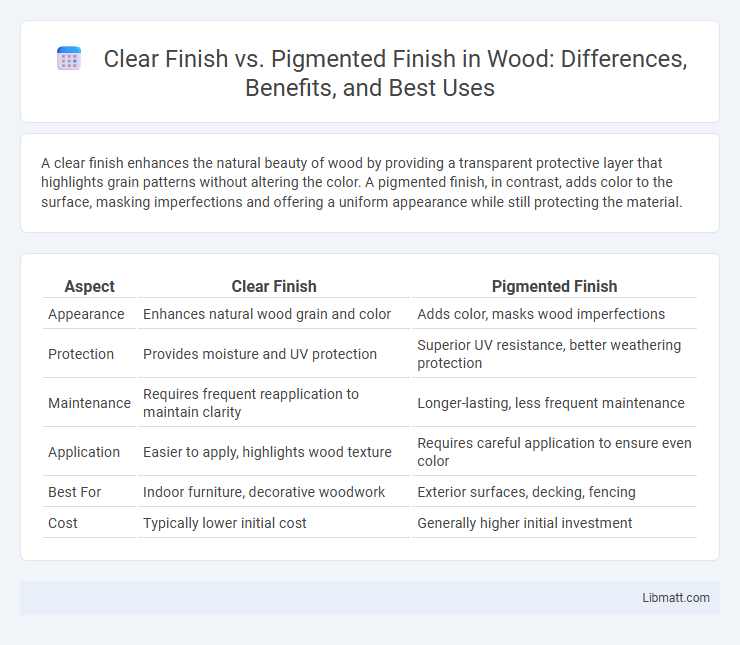A clear finish enhances the natural beauty of wood by providing a transparent protective layer that highlights grain patterns without altering the color. A pigmented finish, in contrast, adds color to the surface, masking imperfections and offering a uniform appearance while still protecting the material.
Table of Comparison
| Aspect | Clear Finish | Pigmented Finish |
|---|---|---|
| Appearance | Enhances natural wood grain and color | Adds color, masks wood imperfections |
| Protection | Provides moisture and UV protection | Superior UV resistance, better weathering protection |
| Maintenance | Requires frequent reapplication to maintain clarity | Longer-lasting, less frequent maintenance |
| Application | Easier to apply, highlights wood texture | Requires careful application to ensure even color |
| Best For | Indoor furniture, decorative woodwork | Exterior surfaces, decking, fencing |
| Cost | Typically lower initial cost | Generally higher initial investment |
Introduction to Wood Finishes
Clear finishes highlight your wood's natural grain and color, providing a protective transparent layer that enhances the wood's original beauty. Pigmented finishes add color and opacity, offering greater UV protection and uniformity while still preserving the texture of the wood. Choosing between these finishes depends on your desired aesthetic and the level of protection needed for your wood surfaces.
What is a Clear Finish?
A clear finish is a transparent protective coating applied to surfaces to enhance durability while preserving the material's natural appearance and texture. Common clear finishes include polyurethane, varnish, lacquer, and shellac, each offering varying levels of gloss and resistance to moisture, scratches, and UV damage. Clear finishes are ideal for showcasing wood grain or original colors without adding pigment or altering the surface tone.
What is a Pigmented Finish?
A pigmented finish incorporates color pigments into the coating, providing a solid, opaque layer that effectively hides wood imperfections and enhances surface uniformity. It offers superior UV protection compared to clear finishes, making it ideal for exterior wood surfaces exposed to sunlight. This finish requires less maintenance over time since it resists fading and can be reapplied without extensive surface preparation.
Key Differences Between Clear and Pigmented Finishes
Clear finishes enhance the natural grain and texture of wood by providing a transparent protective layer, preserving the material's original appearance. Pigmented finishes contain colored pigments that mask defects, add color, and offer superior UV resistance, making them ideal for outdoor use. The choice between clear and pigmented finishes depends on desired aesthetics, durability needs, and exposure conditions.
Aesthetic Impact: Natural vs Colored Appearance
Clear finish enhances the natural beauty of wood by preserving the original grain and texture, offering a subtle, transparent look that highlights the material's authentic character. Pigmented finish provides a uniform, colored appearance that can either complement or dramatically alter the wood's aesthetic, delivering a bolder and more consistent visual impact. Your choice between clear and pigmented finishes depends on whether you prefer to showcase the wood's innate charm or achieve a specific color tone for design purposes.
Protection and Durability Comparison
Clear finish offers a protective layer that preserves the natural appearance of wood while providing moderate durability against moisture and UV damage. Pigmented finish contains color pigments that enhance UV resistance and provide stronger protection against weathering, fading, and surface wear. Your choice depends on whether maintaining wood's natural look or achieving maximum durability against environmental factors is your priority.
Application Methods and Techniques
Clear finish requires multiple thin coats applied with a brush or spray to enhance natural wood grain, ensuring even drying and smooth texture. Pigmented finish, often applied with a roller or brush, masks surface imperfections while providing uniform color and UV protection, demanding consistent strokes to avoid streaks. Both finishes benefit from light sanding between coats to improve adhesion and achieve a professional, durable result.
Best Uses for Clear Finishes
Clear finishes are ideal for showcasing the natural beauty and grain of wood while providing a protective layer against moisture and wear. They are commonly used on hardwood flooring, furniture, and cabinetry where the appearance of the wood is a key feature. Clear finishes excel in environments where preserving original wood color and texture is essential, such as in high-end woodworking and decorative applications.
Best Uses for Pigmented Finishes
Pigmented finishes are ideal for exterior wood surfaces such as siding, fences, and decks due to their enhanced UV protection and ability to hide imperfections. These finishes provide a uniform color that helps block harmful sunlight, reducing wood weathering and extending the lifespan of the surface. Pigmented finishes also excel in environments with high moisture or extreme temperatures, offering superior durability compared to clear finishes.
Choosing the Right Finish for Your Project
Choosing the right finish depends on the desired aesthetic and durability for your project; clear finishes enhance the natural wood grain while providing a protective layer, making them ideal for showcasing the material's beauty. Pigmented finishes offer color and UV protection, ideal for outdoor furniture or surfaces exposed to harsh conditions, allowing customization while preserving the wood underneath. Consider the environment, wood type, and maintenance needs to ensure the finish aligns with both functional and visual requirements.
Clear finish vs pigmented finish Infographic

 libmatt.com
libmatt.com